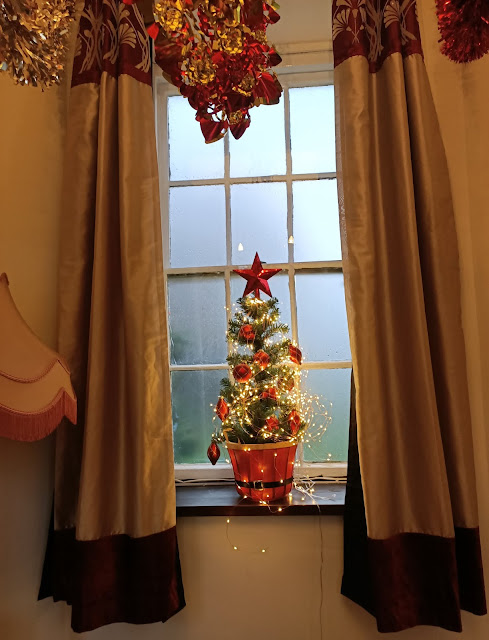Barrons Yew Screen
 |
| Verbena bonariensis, a favourite of bees |
 |
| Crocosmia 'Lucifer' |
 |
| Rosa 'Red Flame with its delicious raspberry scent |
 |
| Our surprise Veronica - not 'Moody Blue' as advertised, but pink, apert from this spire which is half-an-half. Curious! |
The retreat of the Heras fencing to 10 feet from the house has given back the terrace. Well, most of it, anyway, and Shane has set about removing half bricks and broken embedded chimney pots from the paths. Nigel saved this area of the garden becoming the building compound, so I’m very grateful to be gardening there at all this year.
At the end of the terrace is a rather straggly, overgrown yew tree that also narrowly avoided disappearing under the contractors’ yard.
 |
| The straggly yew tree |
 |
| Eight yew trees make up Barron's yew screen |
 |
| The yew screen in its late Victorian heyday. Neat and tidy |
 |
| The yew screen, drawn on Barron's original garden design plans |
In its heyday, this horseshoe of yew encompassed a rather fine curved stone bench, and I recall seeing a photograph of a group of Fletcher-Twemlows in their finery in a formal pose in front of it. When the Browns bought Betley Court, the stone bench was in bits, and in typically Brown family fashion, the stone pieces were repurposed, and pressed into service as steps down to the forecourt side gates.
 |
| The practical opening that the Browns made through the yews, leading down to the forecourt gates |
We have wondered about restoring this topiary feature, especially as it is part of Barron’s original vision for the gardens, and to this end, I found myself looking at a grant application to help us towards the costs of tree surgery, this week. While we were guests of Kew Gardens back in 2018, we spoke to Kevin Martin, the arboricultural manager, to pick his brains on how to tackle such a bold restoration on living trees. The reason yew (Taxus baccata) is so widely used for topiary is its ability to grow new shoots from cut surfaces and low on the trunk, even at a great age. It also responds well to close clipping, allowing it to be shaped into fantastical shapes. In fact, many of Barron’s most famous examples can still be viewed at Elvaston Castle, in the Derbyshire lowlands.
Kevin’s advice was to approach any restoration with care. He counselled us that it must be done slowly, over years. Start with the roots, and pamper the tree with nutrients to gird it for the traumatic process to follow. Then the biggest job, reducing the height, to a foot shorter than we want it to be. That will need a tree surgeon, and possibly permission from the local authority (it might not as hedges are excluded from the same legal protection as trees, but as the yew can be seen from the road, and is in the Betley conservation area, we won’t be taking chances!). Let the trees recover for a year. Reducing the height will have the effect of letting in light, promoting that regenerative growth I mentioned before. Then, it is a matter of cutting back one side, each year, allowing the trees to gently regenerate. Future maintenance involves clipping annually to keep it nice and tidy.
Amazing results have been achieved with this method. Locally, the knot garden and topiary at Little Moreton Hall in in the process of being restored, and although it looked decidedly stubbly last autumn, will look spectacular when the green has filled in again. It would be quite an achievement to do that here at Betley Court.
 |
| Our 'Tommy', singed and bent, but undefeated by the fire. |
Take care in these continuing and peculiar COVID times.
All best wishes
Ladybird Su


Why do you refer to Betley as being in Staffordshire? It is in the borough of Cheshire East. Is this an historical allusion?
ReplyDeleteGod morning Malcolm. What an excellent question! Betley is in the historic Borough of Newcastle-under-Lyme, in the county of Staffordshire. Much confusion about whether Betley is in the county of Cheshire arises as Betley has a Crewe, or 'CW' postcode. In other words postal deliveries to Betley are addressed 'Near Crewe, Cheshire' followed by the six-figure postcode starting CW3. It is to do with which Royal Mail sorting office serves which community. Whilst Betley post comes from Crewe, Cheshire, Betley itself is in Staffordshire, for the purposes of administration, judicial services and politics. The six-figure postcode was first introduced in 1959 by Postmaster General Ernest Marples, and rolled out all over the country by 1974, as a way of rationalising postal delivery.
DeleteIt is one of those peculiarities of the UK postal service that a postal address can be in a different county than the one it is physically in, if it is near a county border. In fact, some are in different countries! Homes and businesses on the Welsh/English or Scottish/English can find their postal address is in a different COUNTRY to their actual location. My own home, for instance, is in Cheshire East, but has a Stoke 'ST' postcode.
Fun fact: one advantage for Betley villagers is that their home and car insurance quotes are cheaper, as quotes are highly influenced by postcode of the policy holder and 'CW' is cheaper than 'ST' postcodes, so there is an advantage!